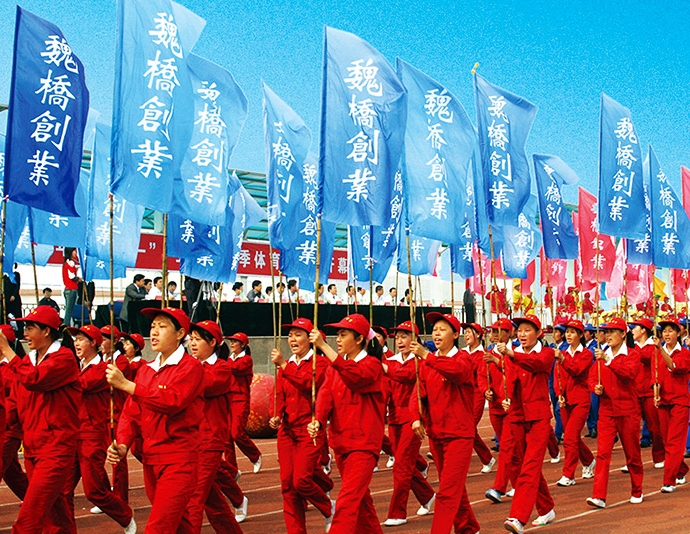China Hongqiao has developed a sophisticated
system to implement its environmental protection goals thoroughly. The
regulatory body inside the company, the environmental protection department,
carries out comprehensive tasks that include formulating internal environmental
policies and guidelines and supervising the implementation process, compiling
environmental risk responding plan, organizing training and emergency drills,
regularly patrolling production facilities and pollutant discharge facilities,
evaluating the environmental performance of each production unit and following
China’s environmental regulations and standards closely.
Hongqiao strictly regulates the treatment and
emission of “three wastes” – exhaust gas, wastewater, and waste, integrating
environmental protection facilities into its production management system. It
guarantees enduring and stable operation of the facilities by monitoring the
compliance status and operating parameters of the outfalls with a 24-hour
real-time surveillance system.
•
Exhaust gas treatment.
The waste gas emitted by China Hongqiao
mainly comes from power plant boilers and aluminum production. The company
strictly abides by the Law of the People’s
Republic of China on the Prevention and Control of Atmospheric Pollution and other relevant laws, purifying the
exhaust gas in the plant to designated standards before emission. Automatic
monitors installed at the exhaust outlet can upload real-time data to the
government’s surveillance platform, helping the government’s environmental
agencies to remotely supervise the company’s exhaust emission. Meanwhile,
devoted to reduce emissions further and to improve the quality of the
surrounding ecological environment, Hongqiao continuously invests in
environmental protection funds for equipment upgrades. The company vows to
excel in environmental protection in every single year. In 2018, it
successfully transformed all generating units to achieve ultra-low emission and
upgraded other equipment to both improve their performance and reduce
emissions.
•
Wastewater discharge
The wastewater discharged from China Hongqiao
is mainly production wastewater and domestic sewage. The company complies with
Chinese laws and regulations including the Law of the People’s Republic of China on Prevention and
Control of Water Pollution, pretreats its
wastewater to meet the Wastewater Quality
Standards for Discharge to Municipal Sewers (GB/T 31962-2015) before discharging into the local municipal
sewage treatment plant through the municipal pipe network. The environmental
protection department conducts monthly sampling tests on the quality of water
at sewage outlets, making sure they meet the standards. The outlets are also
equipped with online monitoring systems that upload real-time data to
government environmental protection agencies.
Hongqiao took comprehensive measures to
improve the efficiency of water consumption and to prevent water pollution. All
wastewater from alumina production is recycled, guaranteeing zero wastewater
discharge. Cooling water used in the casting procession of electrolytic
aluminum is reused. Discharged water from power plants’ cooling water towers
first went for recycling. Spraying and cleaning water of the ex-factory
vehicles are collected, recycled, and used in the coal yard spraying. Fluoride
wastewater from the desulfurization process is processed with desiccant to
reduce the fluoride content and recycled. Rainwater precipitation and
purification tanks are established in aluminum plants to reduce aluminum oxide
powder, fluoride salt, and other pollutants in the rainwater, to prevent
polluted rainwater from being discharged, and to reuse some of the treated
rainwater for production.
•
Waste
disposal.
The final solid waste from China Hongqiao can
be divided into two categories: harmless waste and hazardous waste. The company
implements relevant laws and regulations, including the Law of the People’s Republic of China on the
Prevention and Control of Environment Pollution Caused by Solid Wastes, Pollution Control Standards for General Industrial Solid Waste
Storage and Disposal Sites (GB 18599-2001) and Pollution
Control Standards for Hazardous Waste Storage (GB 18597-2001) to ensure proper management of solid
waste. The company is committed to reducing waste disposal through recycling.
For example, Hongqiao adopts the twin-chamber melting furnace technology to
melt the waste — waste with impurities,
recovered materials from production, market collected waste and clean blocks — generated in the production process.
The company also reuses waste carbon slag
(dregs) from the aluminum smelting process by flotation, which yields electrolyte
powder and toner powder that could be put into future use. Electrolyte powder
is both a raw material for electrolytic aluminum production and a product for
sale. Carbon power, too, can be sold as raw material. Such a project both
reduces pollution and generates considerable economic benefits for the company.
Hongqiao also highlights the treatment of
another major solid waste – red mud, a strongly alkaline, harmful waste from
the alumina production process. Hongqiao strictly follows relevant laws and
regulations to prevent and monitor red mud pollution. After the dehydration and
filtration, red mud is discharged into specially designed storage facilities
with strict leakage prevention and other safety measures. Meanwhile, Hongqiao
has set up control areas around alumina production and red mud storage
facilities and built groundwater observation wells to monitor whether red mud
is polluting the surrounding environment.




